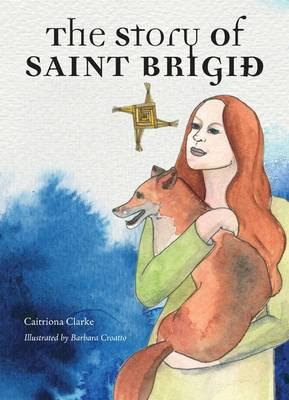Thursday, May 10, 2018
Review: Picture Book - "The Story of Saint Brigid" by Clarke and Croatto
The Story
of Saint Brigid by Caitriona
Clarke, illustrated by Barbara
Croatto, Veritas (2015), 23 pp..
This small, slender, and
well produced picture book in one way resembles adult books about Saint Brigit
more than most picture books: rather than telling a single, unfolding tale, it
picks a number of items of information about the saint and briefly recounts
them, opposite illustrations that highlight one of the items mentioned on each
page. My limited experience with reading books to children suggests that this
sort of thing is often of less interest than a gripping story line. Nevertheless
there are times when this kind of thing is just the ticket, or is at least a
pleasant way to learn a lesson—in this case, who is Saint Brigit? In this particular
instance the book is aimed at Irish school children who will have heard often
about her, perhaps even go to a school named for her, and so will be more
inclined to be curious about the answer to that question than a child who hasn’t
grown up knowing her name. Published by Veritas Publications, it comes from an
unapologetically Catholic perspective.
I like the easy,
conversational tone of the book, beginning with the first page, where Clarke addresses
the child reading the book (or more likely having it read to them). “Have you
ever heard of Saint Brigid? ... Maybe you have made a St Brigid’s Cross out of
reeds? Maybe even your school is named after her!” This engages the child him-
or herself, letting them know that this story is about their lives, too.
I was startled on the
next page of text to learn of Saint Brigit’s mother that, “it is thought she was
captured by pirates in Portugal and brought here as a slave—just like St
Patrick …” I have never heard this before. I am more familiar with the suggestion
that Broicseach was the daughter of Dalbrónach of the Dál Conchobair in County
Meath. I am delighted to learn of another folk geneaology and would love to
know where the idea started and how common the belief is in Ireland. In the
fifteen hundred years since Saint Brigit’s birth there has been ample time for
shifts in and additions to her stories, departures from the texts that I largely
rely on for things like this.
I was also surprised
to read that Brigit’s father, Dubhthach, had chosen to name his daughter after “the
goddess of fire, who was thought to be gifted in poetry, healing, and
craftsmanship.” Of course, there is no basis for this in any of the texts, but
it is a neat way of connecting the two in the mind of the reader without
supposing that they are the same person. This of course would get some backs
up, but as I am of the opinion myself that they are not the same person, though
they have grown together in our modern understanding, it doesn’t bother me at
all, and I appreciate the nod to the goddess.
From this point on
there are no surprises. We are told the familiar outline of Saint Brigit’s
life, pared down drastically for the brevity of a picture book, and learn of the
emphasis in her tales of generosity, compassion, and holiness. Her founding of
a double monastery which was in time to produce great works like the (now lost)
Book of Kildare is an addition which I favour, taking her out of the sweet holy
girl category and placing her into the powerful efficient woman category—a good
model for young people to be aware of.
We are told of the
use of Saint Brigit’s Crosses in Irish homes for protection of people and
animals against illness and their homes from fire, and of her holy wells in
healing. There are some humorous elements, such as the expression of gobsmacked
horror on the king’s face when Brigit’s cloak is spreading out over his land. The
book concludes, “In her, Ireland can proudly lay claim to a wise and charitable
woman who devoted her long life to the service of others.”
I have mixed feelings
about the artwork that accompanies the text. Mostly, I like it. It is has a light
touch which works well with the sparse, friendly writing. There are clean lines
against colourful washes and a good sense of design, and there is, as mentioned
above, a touch of humour in some of the images that appeals. What I don’t like,
and this is purely a matter of taste, is how Croatta draws many of the human
faces, which feel a bit awkward to me.
On balance, I like
this book.
Subscribe to:
Post Comments (Atom)



No comments:
Post a Comment